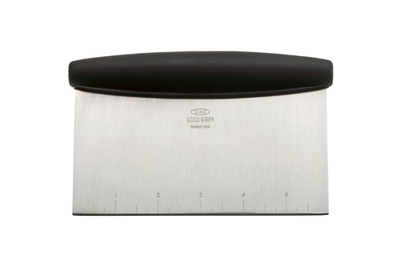I acquired my first bench scraper during culinary school seven years ago, where I was taught to use it to maneuver sticky dough. However, it wasn’t until my first, very humbling day as a line cook at a bustling Los Angeles restaurant that I quickly realized a scraper could do much more than that.
As I stole tear-filled glances around the kitchen between hours of chopping—it was the onions, okay?—I noticed that my colleagues all had one familiar tool in common at their very tidy workstations: a bench scraper. But they weren’t using it to portion dough for baked goods as I had done many times before. Instead, they used the scraper as a mode of transportation, to cleanly and efficiently move piles of chopped ingredients from point A to point B without making an absolute mess (as I was). I came to work the next day with a bench scraper in hand.
This was just the tip of the iceberg in unlocking a bench scraper’s full potential. After working with and observing many cooks in the kitchen over the years, I’ve learned that most seasoned chefs swear by a bench scraper for one reason or another. For some folks, it’s a must-have baking tool that gracefully scrapes away stubborn bits of dough caked onto a cutting board or loose flour collecting in the hard-to-reach crevices of a kitchen countertop. For others, it’s a sharp edge for portioning pizza or pie-crust dough into the appropriate size and shape.
Of course, I also use and love my bench scraper for all of those reasons. However, its versatile meal-prepping abilities are what make it indispensable to me, and now I use it nearly daily to assist with small, mundane tasks like smashing garlic or keeping my cutting board clutter-free (a cardinal rule in the kitchen). I use it to portion dough for pizza night or to frost homemade birthday cakes. It also comes in handy when I’m cleaning up. Wherever I enter the kitchen, my bench scraper comes with me.
After spending almost a decade working in professional kitchens and as a food writer, I’ve acquired at least five different bench scrapers, yet all pale in comparison to my trusted sidekick: the OXO Good Grips Stainless Steel Scraper & Chopper.
The design is, in my estimation, flawless. It has a wide, flat 6-by-4-inch stainless steel surface with an edge sharp enough to effortlessly slice through dough and a nonslip handle for extra stability even when I’m using it with wet hands. And unlike other bench scrapers I’ve used, such as those made of plastic, which warp and stain easily, or those fixed with a wooden handle, which are miserable to clean, this one is the easiest to wash (it’s dishwasher-safe) and the most durable of the bunch.
Unlike the other three that I currently have stashed away, OXO’s bench scraper offers the most surface area for corralling even the tiniest bits of chopped parsley in one swoop—while leaving the fewest scraps behind—and the durability to withstand everyday use. Transporting heaping piles of finely chopped cilantro, parsley, or green onions with my hands cupped together gets messy fast, and using the limited space on the flat of my knife is not just dangerous but also gets me only so far. This bench scraper is much more effective, saving me time while moving chopped ingredients to their next destination and keeping my workstation as mess-free as possible between tasks.

It also comes equipped with a built-in ruler etched into its surface that makes portioning ingredients easy. None of my other scrapers offer this perk. I’ve found the feature particularly helpful when I’m following recipes that have precise measurements or those that call for consistent, evenly sized cuts, such as homemade gnocchi or a presentation-worthy haricot vert salad.

It’s also a lifesaver for frosting cakes. As an avid hobbyist, I recently started making trendy, vintage-inspired cakes for my loved ones’ birthdays, but I’ve discovered that it’s surprisingly difficult and frustrating to achieve a smooth surface when working with super-soft Swiss meringue buttercream and an offset spatula.
Not only does this bench scraper make the process much smoother (pun intended) by gently removing excess material in one even layer, but it also saves me tons of time. For example, I can crumb-coat a two-tier, 6-inch round cake with a bench scraper in nearly half the time I would take to do it with a spatula.

When smoothing the final frosting layer, I briefly run the OXO bench scraper’s stainless steel blade under warm water and quickly dry it off. The residual warmth helps melt the buttercream ever so slightly to flatten any unwanted bumps, bubbles, or lines for a more professional-looking result.
As the name suggests, a bench scraper is also a great scraper. When measuring flour to bake my cakes, I use the sharp edge to ensure the flour is fully packed into the nooks and crannies of the measuring cup before scraping the surface to uniformly level the flour flush to the rim for accurate measurement.

This bench scraper is also the unsung hero that helps clean up after my messes—like the time I spilled an entire quart-size deli cup of thinly sliced scallions all over my station a few days into my first line-cook job. No biggie, though; my bench scraper had my back. And it always will.
This article was edited by Megan Beauchamp and Maxine Builder.





